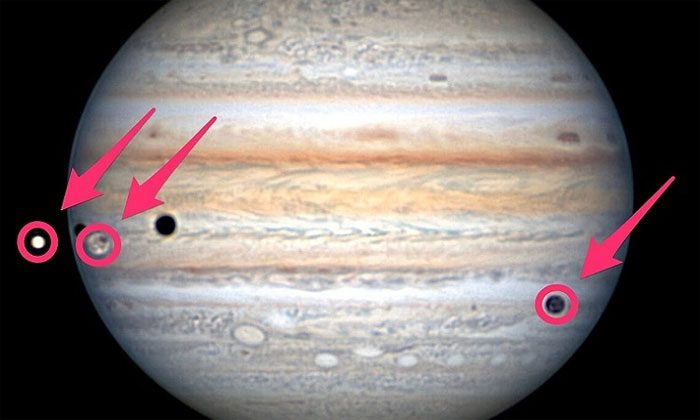The three giant moons of Jupiter, Europa, Ganymede, and Callisto, move across the planet’s surface, casting shadows on the clouds below.
Solar eclipses created by the moons on Jupiter. (Video: Christopher Go/Kunio Sayanagi)
Christopher Go, an amateur astronomer from the Philippines, captured a series of photos documenting this rare event at midnight on May 18. Later, planetary scientist Kunio Sayanagi from Hampton University compiled Go’s images into a video. Each second of the video corresponds to 30 minutes of real-time.
From the surface of Jupiter, the area under the shadow of the moons can witness a solar eclipse. However, from Earth, this phenomenon is referred to as an “occultation” as the moon moves between our planet and Jupiter. Occultations are quite common on Jupiter, occurring several hundred times a year, but it is rare for all three moons to transit simultaneously. According to Sayanagi, the last time the three moons passed between Jupiter and Earth was in 2015, with the next occurrence expected in 2032. “This data is very difficult to collect,” Sayanagi noted.
Go was particularly fortunate to capture this moment as the Philippines is currently in the middle of the rainy season. It rained every evening during the week of the event, but the sky cleared just in time for Go to set up his telescope and observe the trio of moons passing in front of Jupiter.

Occultations are quite common on Jupiter, occurring several hundred times a year.
Additionally, at the beginning of the video, the yellow moon Io briefly appears as it moves behind Jupiter. Following that, the moon Europa passes between the moon Ganymede and Jupiter. Europa, a small icy body with a deep ocean beneath its surface, quickly disappears behind the larger moon Ganymede. When it reappears, Ganymede’s shadow obscures the smaller moon. “It’s fascinating to observe Ganymede’s shadow being split. One half casts onto Europa, while the other half projects onto the surface of Jupiter,” Go shared.
Ganymede is the largest moon in the solar system and has its own ocean similar to Europa. Many scientists believe that the subsurface oceans of these two moons could harbor extraterrestrial life.
Galileo Galilei first observed the four moons in the video—Europa, Ganymede, Callisto, and Io—in 1610. Researchers note that Jupiter has a total of 79 moons, but most are much smaller than the four moons observed by Galileo. Even without its moons, Jupiter’s vibrant clouds and massive storms continue to attract many astronomers.


















































